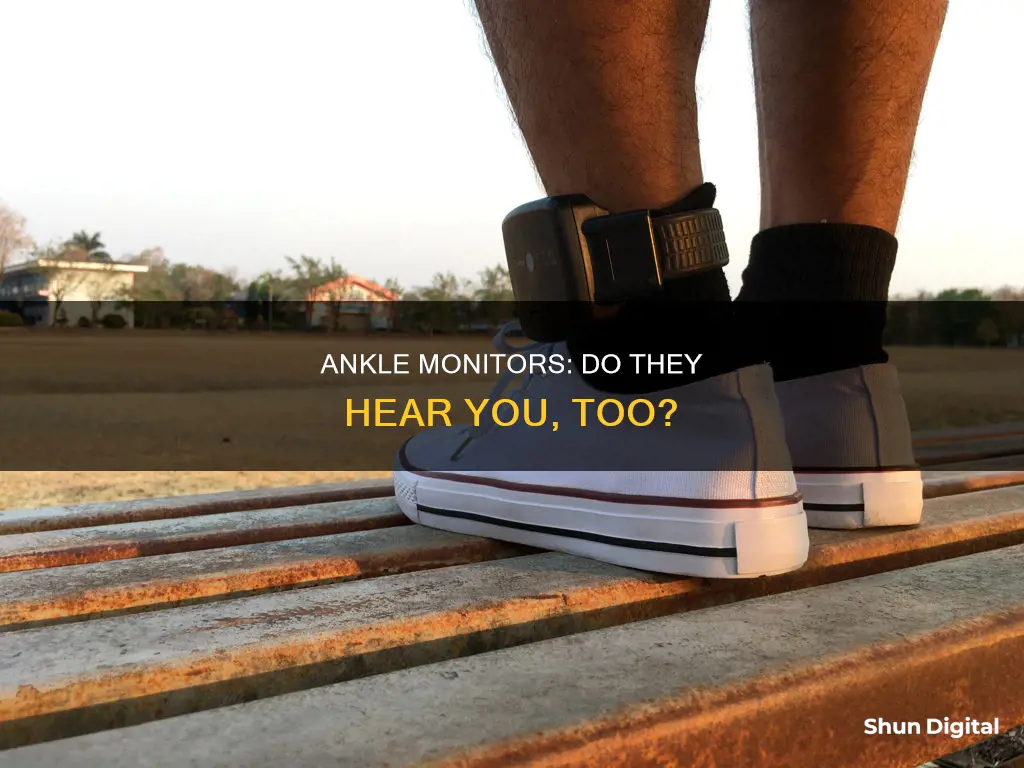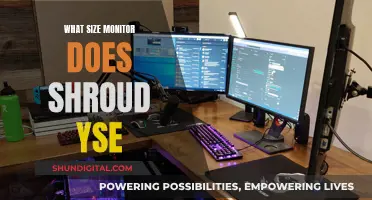
Ankle monitors, also known as ankle bracelets or tags, are electronic devices worn around the ankle that are often court-ordered as an alternative to serving time in jail or prison. They are commonly used for house arrest, parole, or probation, and they work by transmitting the location of the wearer via GPS or radio frequency, allowing law enforcement to track their movement and ensure compliance with court orders. While not all ankle monitors have microphones, some newer models do include this feature, which has raised concerns among civil libertarians and prisoner advocacy groups about potential privacy violations. The primary purpose of the microphone is to enable remote voice identification of the wearer by law enforcement or the monitoring service. However, there have been reports of conversations being recorded without the wearer's knowledge, leading to further concerns about the potential for misuse or infringement on defendants' rights.
| Characteristics | Values |
|---|---|
| Purpose of ankle monitors | Surveillance, to track location |
| Who wears them | Defendants, people on parole or probation, undocumented immigrants |
| How they work | Transmit location via GPS or radio frequency |
| Microphone | Some have microphones, some don't |
| Microphone usage | Voice identification, recording |
| Alerting the wearer | Some monitors vibrate when someone is trying to reach them |
| Ankle monitor issues | Incorrect data, loss of power, lack of secondary data checks, privacy concerns |
What You'll Learn

Ankle monitors may have microphones
Ankle monitors are a form of surveillance, typically transmitting the location of the wearer via GPS. This allows law enforcement to track the wearer's location and ensure they are complying with court orders. However, some ankle monitors also have microphones. The primary purpose of these microphones is to allow the monitoring service or authorities to identify the wearer when they check in.
The inclusion of microphones in ankle monitors has raised concerns about privacy. Civil libertarians and prisoner advocacy groups worry about the potential for eavesdropping and invasion of privacy. While the monitors are intended to provide a degree of freedom for the wearer, the presence of microphones could potentially record private conversations or discussions with legal counsel.
It is important to note that not all ankle monitors have microphones. The feature varies from monitor to monitor and from company to company. Additionally, there are legal restrictions on the use of microphones in ankle monitors. For example, in California, the law states that ankle monitors "shall not be used to eavesdrop or record any conversation, except a conversation between the participant and the person supervising the participant, which is to be used solely for the purposes of voice identification."
Despite these restrictions, there have been concerns about the potential for ankle monitors to record without warning. In some cases, technicians have confirmed that devices can be activated without notifying the wearer, raising questions about the potential for misuse or violation of rights.
Cleaning LCD Monitors: Removing Dust Easily
You may want to see also

Microphones are for voice identification
Ankle monitors are often used as an alternative to prison or jail time. They are commonly worn by defendants who have been sentenced to house arrest or those on parole or probation. The monitor works by transmitting the location of the wearer via GPS, allowing law enforcement to track their movements and ensure they are complying with court orders.
Some ankle bracelets also have microphones. The primary purpose of these microphones is voice identification. The microphones are used by law enforcement as a way of identifying the wearer when they check in. This is done by creating a voiceprint, which is a unique digital format created by capturing the dominant frequencies and tones in the spoken words. Voiceprints are difficult to spoof, as they are based on the innate biological characteristics of a person's voice. This means that the authentication is part of the person and cannot be lost or forgotten.
There are two main methods for voice identification: text-independent and text-dependent. In the text-independent method, vocal samples are captured from regular speech that is random and unplanned. The customer can say anything they want for their passphrase. In advanced systems, the customer's voice is captured passively during a normal conversation, without the need to formally repeat a passphrase. In the text-dependent method, the same words or passphrases are used to capture the voiceprint and subsequently authenticate the customer. Text-dependent voice identification can be static, using the same passphrase every time, or dynamic, using a different randomized passphrase each time.
While microphones on ankle bracelets can be used for voice identification, there are concerns about privacy and the potential for misuse. Some civil libertarians and prisoner advocacy groups worry that the presence of microphones on ankle bracelets could be a violation of a defendant's rights. There have been reports of ankle bracelets recording conversations without notifying the wearer, which further adds to the concerns surrounding these devices.
Monitoring PSU Usage: A Comprehensive Guide to Tracking Power Supply Performance
You may want to see also

Ankle monitors can record without warning
Ankle monitors are electronic devices fitted to individuals as an alternative to serving time in prison or jail. They are often court-ordered for defendants on house arrest, awaiting trial, on parole, or on probation. These devices are typically used for surveillance, transmitting an individual's location via GPS or radio frequency to allow law enforcement to track their movements and ensure compliance with court orders.
While the primary purpose of ankle monitors is location tracking, there have been concerns about their potential to infringe on privacy. In recent years, more sophisticated GPS ankle monitors have been introduced, and some of these newer models have been found to include microphones and recording capabilities. The inclusion of microphones in ankle monitors is intended to facilitate remote voice identification by law enforcement or probation officers.
However, the presence of microphones has raised concerns among civil libertarians and prisoner advocacy groups. While ankle monitors with microphones are supposed to emit a warning sound or vibration before activating the microphone and speaker, there have been reports and technical confirmations that these devices can be turned on without providing any notification to the wearer. This lack of warning raises serious privacy concerns, as it potentially allows for the recording of private conversations or discussions with legal counsel.
The legality of ankle monitors with microphones varies depending on the jurisdiction. For example, in California, the Penal Code Section 1203.016 PC specifically states that ankle monitors "shall not be used to eavesdrop or record any conversation" except for the purpose of voice identification. Despite this, the advanced features of newer ankle monitor models and the potential for unauthorized activation have sparked debates about potential violations of defendants' rights.
Removing Anti-Glare Coating: DIY Monitor Makeover
You may want to see also

Ankle monitors are used for house arrest
Ankle monitors are often used as an alternative to prison or jail time, with judges frequently requiring individuals to wear them during probation or as pre-trial conditions. They are also used for those on parole or house arrest. The use of ankle monitors increased during the pandemic, as jails released incarcerated people due to the risk of coronavirus outbreaks.
Ankle monitors are a form of surveillance, transmitting the location of the wearer via GPS or radio frequency. This allows law enforcement to track the wearer and ensure they are complying with court orders. They are also used to monitor alcohol consumption for those with alcohol-related offenses.
The use of ankle monitors is controversial. While they can help reduce prison populations and allow individuals to continue their lives outside of jail, critics argue that they do not address systemic issues that lead to incarceration. There are also concerns about the accuracy of the data collected, and the lack of privacy for the wearer.
In terms of their use for house arrest, ankle monitors can be used to ensure that individuals remain within the boundaries of their designated area. They can also be used to allow for travel to specific locations, such as work or religious services, with prior approval.
Overall, ankle monitors provide a way to monitor and restrict the movements of individuals on house arrest, but their effectiveness and impact on civil liberties are debated.
Connecting a Second Monitor: Easy CPU Setup Guide
You may want to see also

Ankle monitors can track alcohol consumption
Ankle monitors, also known as ankle bracelets or SCRAM bracelets, are often used as an alternative to serving time in prison or jail. They are commonly worn by defendants who have been sentenced to house arrest or those on parole or probation. These devices are equipped with GPS tracking capabilities, allowing law enforcement to monitor the wearer's location and ensure compliance with court-ordered restrictions.
In recent years, there has been a growing concern about the amount of information ankle monitors can collect, including the possibility of them having microphones. While not all ankle monitors have built-in microphones, some newer models do include this feature. The primary reason for including a microphone is to allow probation officers and law enforcement officials to remotely identify the wearer. However, it is important to note that the presence of a microphone does not necessarily imply that the state can eavesdrop on private conversations. In California, for example, the use of ankle monitors with microphones is regulated by the Penal Code Section 1203.016 PC, which prohibits their use for eavesdropping or recording conversations without consent.
Ankle monitors have also evolved to address specific concerns, such as alcohol consumption by repeat offenders of drinking-related crimes. These specialised monitors, known as SCRAM CAM bracelets, provide continuous alcohol monitoring by sampling the wearer's perspiration every 30 minutes. This non-invasive method detects alcohol excreted through the skin, providing an accurate indication of alcohol consumption. The data collected by the SCRAM CAM bracelet is transmitted wirelessly to a base station and can be used to support long-term behaviour change and complement treatment for alcohol dependence or addiction.
The use of SCRAM CAM bracelets has been proven effective in reducing reoffending rates among high-risk drunk drivers. By providing 24/7 transdermal alcohol testing, these bracelets encourage accountability and increase compliance with court orders. They are often court-ordered in cases involving drunk driving, domestic violence, and substance abuse charges. The bracelets can distinguish between alcohol consumption and external environmental sources, and they also feature anti-tampering technology, ensuring the integrity of the monitoring process.
While ankle monitors with alcohol-tracking capabilities do not directly address the privacy concerns associated with built-in microphones, they demonstrate the evolving nature of this technology and its potential impact on civil liberties. As technology advances, it is crucial to strike a balance between effective monitoring and the protection of individual privacy rights.
Destroying an LCD Monitor: Step-by-Step Guide
You may want to see also
Frequently asked questions
Not all ankle monitors have microphones. Some do, and some don't. The feature varies from monitor to monitor and from company to company.
No, it is against the law for the state to use the built-in microphone to do anything other than verify your identity. Any other conduct would likely be a violation of your 4th and 5th Amendment rights.
Yes, some ankle monitors with microphones can be activated remotely and record conversations without the wearer's consent. However, there are no reported cases of the state abusing this feature.







